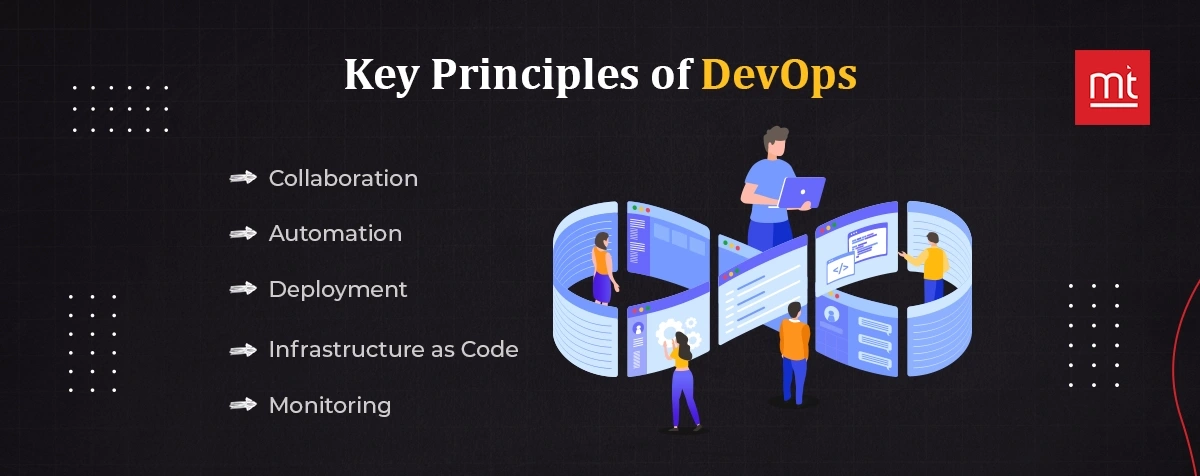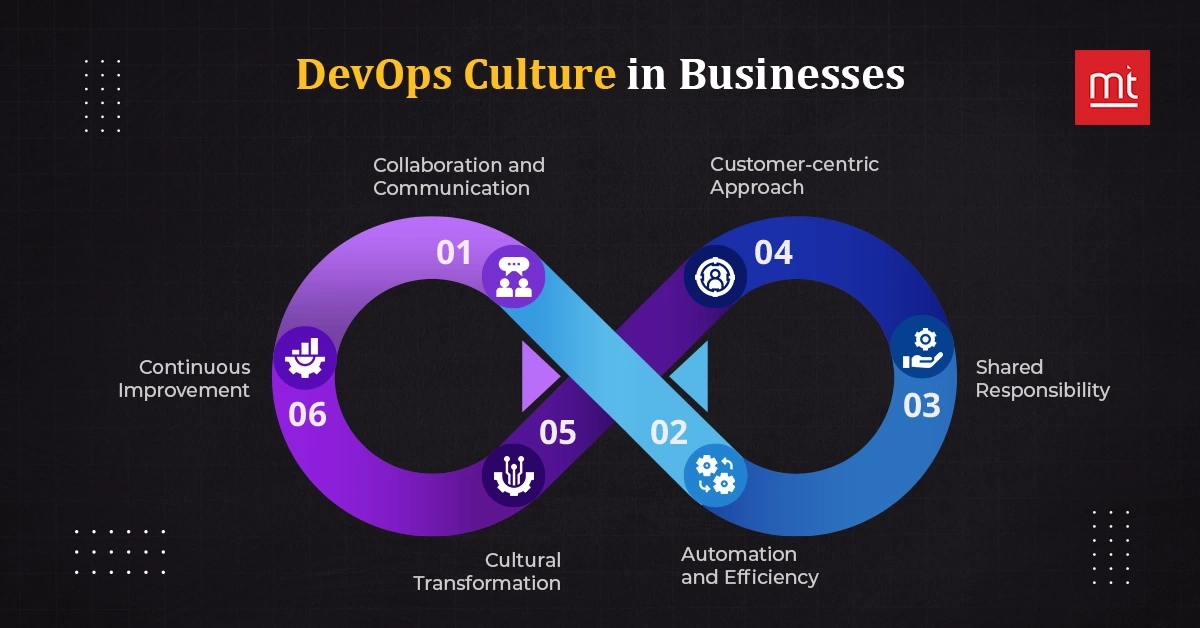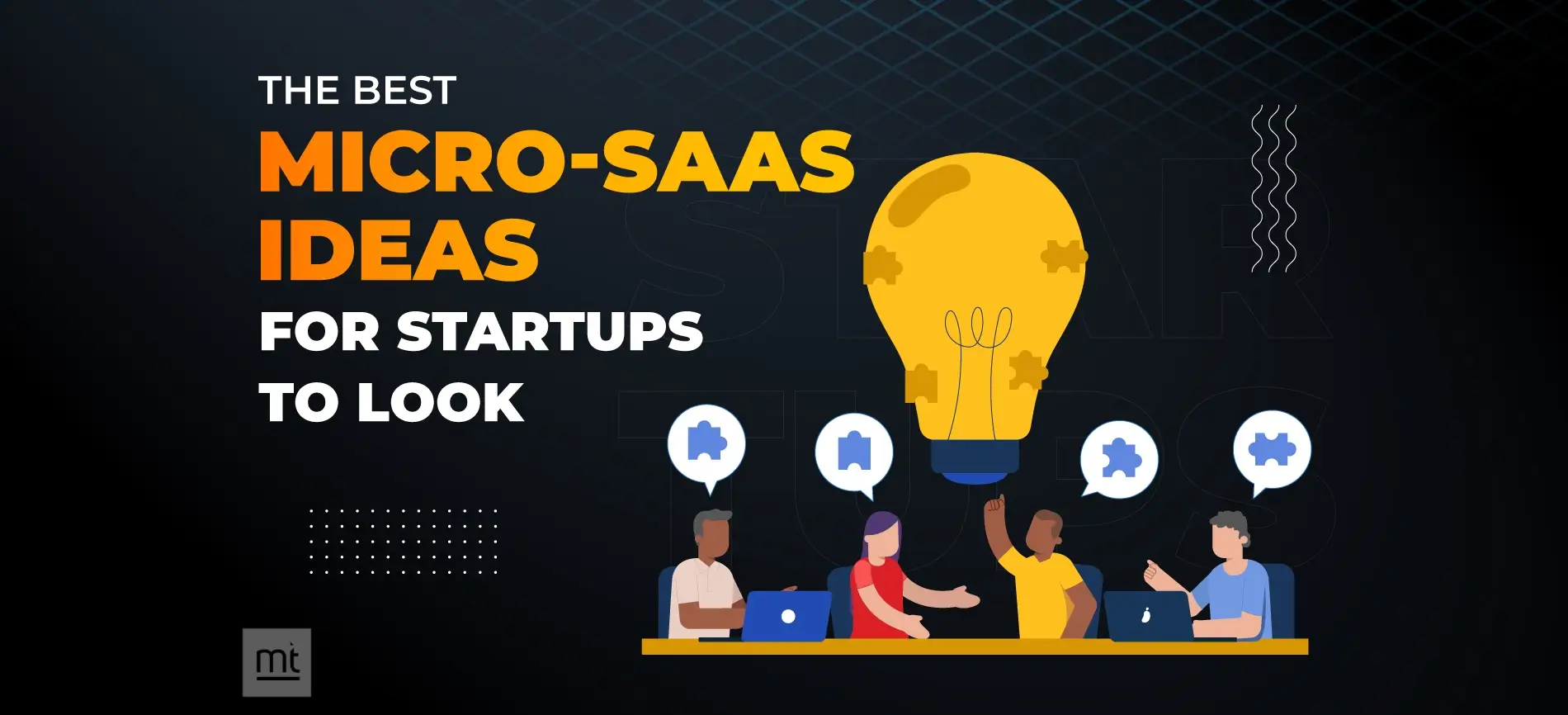Introduction:
In the fast-paced business ecosystem, organizations are grappling with the challenges of delivering high-quality software rapidly. They must not only ensure swift operations but also efficient processes for streamlined delivery. DevOps has identified this pain point and helped develop a robust framework to help businesses stay at the helm of app development.
DevOps, the beautiful amalgamation of development and operations, is more than a methodology. It is a culture and a collaborative mindset that eliminates the silos and fosters continuous movement. It caters to the continuous improvement and constant integration needs of the businesses.
Continuous integration and deployment are core to the DevOps lifecycle along with collaboration and automation. In 2021, 83% of all the decision-makers implemented DevOps to unlock higher value for their business. When the two teams align, they ensure smooth software delivery.
This article is an exploration of the DevOps culture. You will learn the benefits of integrating DevOps in your development lifecycle to achieve continuous integration and continuous deployment. It will help you learn how this cultural shift can help you attain a competitive positioning in the business landscape.
Overview of DevOps
DevOps, the amalgamation of development and operations, proposes a collaborative culture and development practices for unified development. It assures efficient processes and swift delivery for rapid app development.
This culture emphasizes automation, continuous integration and continuous deployment for a feedback-driven development approach. DevOps breaks the silos to encourage a collaborative culture.
When businesses use Jenkins to automate builds, Docker for containerization and Kubernetes for orchestration, it exemplifies DevOps culture. This integrated approach will foster continuous improvement of the development lifecycle.
Key Principles of DevOps

- Collaboration is core to DevOps. This culture focuses on ensuring seamless communication and collaboration between the development and operational teams. The stakeholders unify to achieve the goals.
- Automation helps streamline repetitive tasks to reduce errors and ensure high-quality software. You can also address the integration and compatibility issues with this culture.
- You must continuously deploy the code between staging and production environments for the build-to-test process. This would reduce the iterations and errors. It can help you launch a well-optimized and user-centric code.
- Infrastructure as a Code is crucial to DevOps practice. You can use this feature to manage and provision for machine-driven scripts. This can help ensure consistent and scalable infrastructure for the business application.
- DevOps focusses on continuous monitoring to get feedback on the development and performance of the infrastructure. Feedback loops can help address the issues and make the necessary improvements.
Benefits of DevOps
- DevOps extends rapid development for quick launches and quicker feature additions. You can use this to your advantage when focusing on creating a user-centric and usable application
- As the different teams don’t work in silos, DevOps can foster accountability and shared responsibility. You can also enable faster resolutions
- It automates the workflows and ensures continuous improvement, which enables cost-savings in the long run.
Disadvantages of DevOps
- You may face resistance and internal issues when implementing DevOps. Your organization must ensure change management before adopting a DevOps culture.
- When implementing DevOps, you may face security issues. You need a robust security strategy to implement DevOps.
- You must have a defined strategy and infrastructure to manage the complexities of this culture.
The DevOps Culture in Businesses
DevOps is not just a technological advancement for the business. It is a cultural change that will redefine the way your teams will connect to add value to the business.
Here is how DevOps culture will impact a business to attain goals.

#1. Collaboration and Communication
- The DevOps culture eliminates the silos that were part of the traditional development approach. They encourage cross-functional teams with diverse skill sets for seamless collaboration and effective outcomes
- It fosters an open communication channel to ensure a seamless connection between the teams. It will help address the diverse challenges and attain the common objectives.
#2. Automation and Efficiency
- You can automate the repetitive manual tasks to enhance the organisation’s efficiency. It helps automate the development to testing workflows for consistency
- DevOps culture prioritizes the correct infrastructure to enable automation and innovation
#3. Shared Responsibility
- You can ensure shared accountability in cases where there are issues or bottlenecks. This would reduce the accusations in an organization and foster a more supportive environment
- You will foster a culture of ownership throughout the project lifecycle. You can ensure a more holistic problem-solving approach.
#4. Customer-centric Approach
- You can create a software solution that focuses on the customers to enhance the overall usability and experience
- It also helps deliver user-centric features and meet the evolving customer needs with your software
#5. Cultural Transformation
- Your leadership plays a pivotal role in ensuring the seamless implementation of DevOps. They will guide you through the transformation and help you address the resistance
- Your teams must have the skills and training to embrace DevOps. You can introduce skill development programs to eliminate the gaps.
#6. Continuous Improvement
- This culture fosters iterative process, continuous improvement and feedback loops for a more user-centric solution
- They will introduce feedback loops for customers and internal employees for data-driven insights for informed decisions.
Overview of Continuous Integration
Continuous Integration is an integral part of the DevOps culture. In this approach, the teams would frequently commit the code changes to the shared repository. This would help them identify and address the issues during the early stages of development.
Moreover, this method also helps keep the codebase in a functional stage. By automating the build-to-test pipeline, you can release high-quality software into the market.
Key Features of Continuous Integration
- Continuous integration encourages frequent code changes to the shared repository for quick resolutions and faster commits
- You can automate the builds and compile the code to ensure consistent coding and early bug fixes
- You get immediate feedback from the customers on the issues and pain points with the software solution. You can implement the feedback and ensure a user-centric solution
- You can rely on the version control systems to keep track of the code changes. This would help you roll back to the previous version in case of issues.
Best Practices of Continuous Integration
- You must maintain a central repository to maintain the single source of codebase for your business application. You can use this to make the essential changes and update the codebase
- Automating the build process can ensure a consistent and simple application development process. You can easily identify the errors with the automated process
- You must implement a comprehensive infrastructure to help identify and address the issues. This pipeline would help with unit, integration and functional tests. You can validate the code and identify the regressions
- You must isolate the changes and issues before working on them. You can integrate them later into the main branch for a successful build-to-test pipeline.
Benefits of Continuous Integration
- It helps detect and fix the bugs in the early stages of development to save time and costs
- Automated build-to-test workflow can ensure a consistent codebase to deliver quality solutions
- You can accelerate the development cycles to facilitate quick feedback and reliable updates.
Overview of Continuous Deployment
Continuous deployment continues the continuous integration pipeline towards deployment. It encourages automated code deployment into the production stage once they are given a clean chit.
The CD pipelines can ensure continuous delivery of the code to promote rapid releases. It also reduces the manual intervention for accurate code development.
Key Features of Continuous Deployment
- It automates the deployment process. You can easily avoid manual intervention, which would ensure high-quality and error-free code deployment
- You can set up a release pipeline through the development, testing and production stages. You can automate the different stages, thus ensuring a stable codebase deployment.
- You can enable the code changes incrementally. This reduces the quality and error risks associated with large-scale software deployments.
- You can also use the pipeline as a rollback mechanism to address the issues. It will also enable quick recovery from deployment issues.
Best Practices of Continuous Deployment
- You can commit to comprehensive testing strategies using automated tools to ensure the stability and usability of the codebase
- You must implement the feature flags/toggles that can enable/disable features in the production stage. You can use this practice to control the feature releases
- You must also implement immutable infrastructure to ensure that the server and infrastructure are disposable entities. It will help maintain consistency.
- It fosters an open communication and collaboration channel between the development and operations teams. This can help solve the issues faster.
Benefits of Continuous Deployment
- The continuous deployment ensures a streamlined deployment process that enables faster and more reliable delivery. You can reduce the timelines to add features
- You don’t need manual intervention in the CD pipeline. This would reduce the errors and enable consistency
- The pipeline fosters reliable deployment. You can also automate the testing and rollback mechanisms for a more stable production environment
- You can also introduce the feedback loop in the production environment to improve the app continuously. The CD pipeline combined with CI will help deliver value to the users.
How CI and CD Work to Enhance DevOps?
The CI/CD pipeline is integral to DevOps culture. They will help implement automation and enhance collaboration throughout the organization. Each pipeline enhances the DevOps cycle and strengthens the development cycle.
#1. CI-based Enhancements to DevOps
- When you introduce CI to your DevOps culture, it helps determine the bugs and issues in the early phases of development. You can reduce the likelihood of issues and mitigate the risks with this approach
- It helps build and test the code for consistency and quality. You can also prevent regression issues and ensure the codebase is ready to deploy
- The collaborative nature of the continuous integration ensures that the developers and other stakeholders share a sense of responsibility towards the project.
#2. CD-based Enhancements to DevOps
- Continuous deployment automates the delivery process for faster and more reliable delivery for software consistency. You can easily deploy the features and updates to the production environment
- It can automate the deployment process to reduce manual intervention. It can eliminate the risks of human intervention. You can promote consistency through environments
- You can add a feedback loop to organize the error identification process. It helps you identify and debug the issues faster to improve the software. It can also deliver value to the users.
How Do They Help DevOps Together?
- You can ensure end-to-end automation via CI/CD pipelines. This ensures complete code integration and deployment.
- You can minimize the manual interventions for accelerated software delivery and rapid deployments
- Align the CI/CD pipelines with the DevOps principles for collaborative and continuous cycles. This will help increase the agility, efficiency and effectiveness of the software.
Security Implementation in DevOps CI/CD
It is crucial to implement robust security practices while implementing the CI/CD pipelines. You can use this in combination with DevOps culture to create a reliable and secure software solution.
Here are some of the security aspects you must implement in the CI/CD pipeline.
#1. Static App Security Testing
You must integrate the SAST tools into your continuous improvement pipeline. It can help analyse the source code to manage the vulnerabilities before committing the code to the shared repository.
Configure the continuous integration server to trigger the SAST scans for code deployment. You can analyse these results to gather insights and implement them to mitigate the issues.
#2. Dynamic Application Security Testing
You can use the DAST to scan the app in runtime and mitigate the security issues.
- Run the scans in the pre-production environment and integrate the results into the feedback loop
- You can use this testing method to scan the production environment for bugs and release stable software
#3. Dependency Scanning
You can use this scanning tool to identify and mitigate the bugs in third-party libraries and dependency tools.
You must scan these dependencies. Create the dependency inventory to manage and monitor the security updates. You can also use the process to update the security when patches are available.
#4. Container Security
You must integrate the container security tools to scan the container images and check them for vulnerabilities.
For this purpose, you must scan container images to ensure they meet the security standards before deploying them. You must also employ the policies to reduce the vulnerabilities within the containers.
It is equally important to monitor the container images and update them with security patches.
#5. Automated Compliance Check
Implement the automated checks to ensure your software meets the regulatory and compliance requirements.
You must determine the policies and check if your software meets the standards and regulations. You must also include the compliance checks in the CI/CD pipeline.
Top Case Studies
1. Amazon
Amazon transformed the software delivery process by adopting DevOps practices. They included CI/CD pipelines to automate the build-to-commit process. They were able to enhance the speed and agility of development with this change. They could also mitigate deployment failures.
2. Netflix
Netflix is a pioneer of streaming services. they implemented a DevOps culture to overcome the scalability challenges. This solution helped them leverage microservices architecture and cloud computing for the best outcomes. Moreover, it also helped improve scalability and rapid innovation.
3. Etsy
Etsy is an eCommerce platform that implemented DevOps with CI/CD to improve the project lifecycle. They were able to enhance the system’s reliability with continuous deployment. They also managed to improve the release frequency and reduce deployment time.
4. Target
They improved the overall collaboration between their development and operations teams with the DevOps practices. It also helped them collaborate for faster releases and quality software.
Challenges and How to Overcome Them
Here are all the challenges you might face when planning DevOps implementation
1. Resistance to Change
Your employees or teams may resist the changes to the development and operations workflows/processes. To overcome this challenge, you must communicate the need for change and showcase the benefits to the teams.
2. Existence of Silos
The traditional structures are made of silos. This restricts collaboration among the teams for development efficiency.
You can overcome this by building cross-functional teams to collaborate on project development. You can ensure shared goals and responsibilities for successful outcomes.
3. Security Concerns
Your biggest challenge is reducing the vulnerabilities while developing the application. You can overcome security issues via automated security testing services. You can ensure the development and testing teams to collaborate on addressing these issues.
Conclusion
DevOps is a transformative philosophy that prioritizes collaboration, automation and continuous improvement for reliable software delivery. This culture change breaks down the silos and fosters an efficient workflow. You can use tools like CI/CD pipelines, version control and IaC for rapid development, and release cycles.
You must implement the DevOps and CI/CD best practices to deliver stable and high-quality solutions. ManekTech is abreast with the DevOps implementation best practices. Our team can implement these principles for swift deployment and frequent releases.
Connect with our team to harness the potential of DevOps and CI/CD to enhance your software quality.
About Author
Subscribe to Our Newsletter!
Join us to stay updated with our latest blog updates, marketing tips, service tips, trends, news and announcements!




















